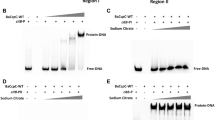Abstract
For the CitA-CitB (DpiB-DpiA) two-component signal transduction system from Escherichia coli, three diverse functions have been reported: induction of the citrate fermentation genes citCDEFXGT, repression of the regulator gene appY, and destabilization of the inheritance of iteron-containing plasmids such as pSC101. This poses the question of the principal biological role of this system. Here it is shown that the periplasmic domain of the E. coli sensor kinase CitA functions as a high-affinity citrate receptor. Two CitA derivatives were purified by affinity chromatography and subjected to binding studies using isothermal titration calorimetry (ITC). One of them, termed CitAff215MBP, comprised the N-terminal part of CitA (amino acid residues 1–215), including the two transmembrane helices, and was fused to the amino terminus of the E. coli maltose-binding protein lacking its signal peptide. The second CitA derivative, designated CitAPEc, encompassed only the periplasmic domain (amino acid residues 38–177). CitAff215MBP bound citrate at 25 °C with a K d of 0.3 µM and a binding stoichiometry of up to 0.9 in 50 mM sodium phosphate buffer, pH 7. Binding was driven by the enthalpy change (ΔH of –95.7 kJ mol–1), whereas the entropy change was not favorable for binding (TΔS of –58.6 kJ mol–1). ITC experiments with CitAPEc yielded similar K d values for citrate (0.15–1.0 µM). Besides citrate, also isocitrate (K d ~15 µM) and tricarballylate (K d ~50 µM), but not malate were bound by CitAPEc. The results favor the assumption that the primary biological function of the CitA-CitB system is the regulation of the citrate fermentation genes.
Similar content being viewed by others
Author information
Authors and Affiliations
Corresponding author
Rights and permissions
About this article
Cite this article
Kaspar, S., Bott, M. The sensor kinase CitA (DpiB) of Escherichia coli functions as a high-affinity citrate receptor. Arch Microbiol 177, 313–321 (2002). https://doi.org/10.1007/s00203-001-0393-z
Received:
Revised:
Accepted:
Published:
Issue Date:
DOI: https://doi.org/10.1007/s00203-001-0393-z




